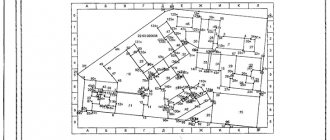Home / Real estate / Land / Ownership
Back
Published: 07/24/2017
Reading time: 5 min
0
169
All land available in the country is divided by type of right into private and state. When purchasing a plot, depending on the form of ownership, a purchase and sale agreement can be concluded with a private person (private property) or with a government agency (state property).
The procedure for acquiring state land of various forms of ownership complies with the provisions of the Land Code of the Russian Federation and is, as a general rule, uniform, with the exception of possible nuances provided for by decisions of state bodies of the constituent entities.
- Purchasing a plot from a private person Preparation of documents
- Preparation of contract
- Receipt for receipt of funds under the agreement
- Registration of the agreement
- Provision of a plot at auction Formation of a land plot
What is this
The concept means the relationship between distribution and appropriation. Characterizes the right of a subject (legal entity, individual or group of persons) to dispose of its property rights, having certain goals.
Today, in order to determine which 4 main forms, types and subtypes of property are enshrined in the state, you can study the provisions in civil law, data in Russian legislation regarding the scheme and special specified codes, and also study the provisions provided for in the Constitution of the Russian Federation.
Procedure for seizure of land
The procedure and legislative procedure for the seizure of land from citizens are enshrined in land legislation and imply compliance with several key stages (carried out in accordance with Articles 279-281 of the Civil Code of the Russian Federation):
- Once a decision is made to confiscate land owned by citizens for state or municipal needs, government agencies must send a written notification to the owner no later than 1 year before the repurchase takes place.
- The rules and procedure for the seizure of land ownership provide for separate guarantees for citizens, implying that within a specified period after the resolution is received, the plot cannot be seized without the will of the subject of legal relations, whatever the reasons for the emergence of state needs.
- Next, the price bidding procedure takes place: government agencies and the owner of the plot set a ransom price for the land of interest.
Varieties
Society cannot exist without any variety of personal or social material values. The question of how they are distributed is relevant for many.
The ownership of material assets is determined in compliance with legal requirements. The law recognizes the existence of equal management conditions based on various selection criteria. Therefore, it is required to know what types and organizational forms of ownership there are, what property relationships exist among organizations, what rules exist in the Russian Federation, to what extent they are recognized as correct in modern Russia and what features exist in the provisions of the Russian Federation.
A Russian citizen can have legal ownership in the Russian Federation and be protected by law in his rights to material assets on the basis of existing legal norms. The norms are subject to the form of ownership of a private individual or organization of a legal entity, be it an LLC, a representative office of a limited liability company, a joint stock company, a state federal company or another owner of an object or objects, which are by definition.
In this regard, the Civil Code of the Russian Federation classifies 4 types of property and identifies the main managers.
State
The copyright owner is the Russian Federation. All results of labor obtained during exploitation belong exclusively to the state.
An important role in the country’s economy means:
- The need for this type is due to those industries where private business cannot exist. This is, for example, the energy supply sector or railway transport.
- The state type is characteristic of the production of public goods. These are the most important areas that include the defense capability of the state.
- Enterprises that were nationalized during the period of economic restructuring are also included.
A distinctive feature is the form of losing to private ownership in relation to economic efficiency indicators. In the case of state ownership, the interest in control is lower.
Municipal
Based on Article 8 of the Constitution of the Russian Federation, the municipal type of ownership is characterized as an independent category and is not considered state-owned. This method of management is distinguished by a specific order of ownership. The right to dispose of property is given to self-government bodies, since this right is the result of the will and interests of the local population.
Municipal ownership is considered to be the ownership of urban property, rural property and ownership of other municipal entities. Municipal assets are taken into management on the basis of the procedure established in Part 2 of Article 125 of the Civil Code of the Russian Federation. According to the regulations, the right to dispose of structures is given to local officials. In some cases, the population receives this right.
Property of a local nature is targeted. This is the basis for its characteristic aspects, operational methods, and features.
Municipal type of ownership is required to solve the following problems:
- To quickly resolve issues at the regional level.
- To solve the problems set by the state and government to local authorities.
- So that local governments can fully function.
Private
The single individual private type of ownership, given the 3 types of ownership, additionally includes the partnership and corporate varieties, which together are inferior to the state form of ownership when it comes to determining the included types.
The type of management distinguishes two main types: individual and public. Each type corresponds to legally justified subcategories that have legal characteristics. Their detailed description is contained in the Civil Code of the Russian Federation.
In turn, the individual variety is divided into the following types:
- A type of unity when all benefits belong to a single citizen who has the right to attract hired workers.
- Type of partnership , characteristic of an association of individuals, for the purpose of conducting business activities, maintaining industrial relations, which corresponds to the type and form of ownership in Russia.
- Type of cooperative . Persons who sell free shares and create capital.
The main social species is characterized by several subspecies:
- Collective. When management rights are equally divided among employees.
- State. When a city or town owns the property.
- Nationwide. If the values belong to state residents. For example, museums or memorial sites.
- Combined. An entity created by combining different types of property.
It is also important to know about the joint and shared types of management available to each person. The Russian Federation recognizes various types of management, following the forms of ownership, including the property of an enterprise in Russia may belong to private individuals living in the Russian Federation, when it can be distributed among them in equal shares under equal conditions.
Public
The owner and manager is society, designated as a collective subject.
The municipal type of ownership, public and corporate represent the organizational and legal form for each type of property and when it concerns public property separately. This variety represents three types of property ownership:
- State. The internal activities of the country are indicated here. Carrying out nationalization, construction of buildings and structures using federal budget funds.
- Collective. Affiliation with public organizations, churches, parties.
- Municipal. The property is managed by local authorities.
If it is necessary to carry out boundary work to form the boundaries of the site
The decision to carry out such work (step 4) is made simultaneously with the decision to provide the site to the municipality (step 3), in accordance with clause 9 of Art. 39.31 Land Code of the Russian Federation.
The application must be submitted by the head of the municipality or his deputy, in accordance with paragraph 1 of Art. 39.31 Land Code of the Russian Federation.
The application must contain information:
- On the purposes of land transfer;
- About the cadastral number of the plot;
- About the municipal formation.
In case of refusal, the head of the municipality must be provided with reasons in writing. A refusal can be obtained in accordance with clause 7 of Art. 39.31 of the Land Code of the Russian Federation, in the following cases:
If the plot indicated in the application is not transferable;
- The application does not contain the cadastral number of the plot, coupled with the lack of a diagram of its location;
- The site has already been demarcated into another type of state property;
- The provided diagram does not meet the department's requirements.
There is no cadastral number when the plot is not formed; in this case, you must attach a diagram on the basis of which cadastral work will be carried out to determine the boundaries.
What do you need to know if a minor is involved in a real estate transaction? Read about it in our article.
With the help of a life annuity you can purchase real estate relatively cheaply. You can find out more in our material.
Main differences
The name of the legal form of ownership (state, private or legal entity) contains answers to questions, including what types there are according to the all-Russian classifier OKOPF, what is the difference with OKFS.
In all the stated provisions, differences between owners are seen. These differences are encrypted in codes. Each code according to the all-Russian classifier has its own number and together all codes represent a list of forms of ownership recorded in the Civil Code of the Russian Federation, which is access to data on a particular organization, for example, an LLC with the ability to be determined in the OKFS by TIN online.
Private, public, and state ownership of valuable and material assets are divided into opposite concepts. The peculiarities of state, municipal form (MAU) or private property in the Russian Federation can be found according to the legislation of the Russian Federation.
Accordingly, there are a lot of differences between the above concepts of legal ownership. The list of main differences includes:
- Freedom to own.
- Division of financial responsibility.
- The difference is in behavior control.
- Commensurability of interests.
- Target directions.
Registration of ownership
Since 1998, the only place that can confirm ownership of property is the Unified State Register of Rights (USRP). To receive an extract, you need to order it from Rosreestr.
If the right of management has not yet been registered, then you need to apply to the nearest multifunctional center (MFC), attaching a package of documents.
List of required documentation:
- statement;
- passport;
- certificate of purchase of real estate;
- document on registered persons;
- cadastral passport;
- a receipt confirming payment of the state duty.
Depending on the specific circumstances, MFC employees have the right to request additional documents.
Mixed form
A mixed or, in other words, joint form of ownership corresponds to combined rights; this largely determines its form of ownership.
To support certain activities of enterprises of various types, the state allocates resources to them. In such conditions of cooperation, the state and the enterprise receive their share of the profits.
We can also recall the housing issue. The forms of ownership of the housing stock are denoted by civil law, and if one is guided by this law, the legislation of the Russian Federation recognizes the following types of funds: private, state, municipal.
In the Russian Federation, the following types of land ownership are being implemented: state federal, state regional, municipal, private.
Transfer Features
Federal land plots are transferred to municipalities exclusively on the principles of free of charge and taking into account targeted programs at the regional and all-Russian levels.
If a refusal was received due to the impossibility of transferring this plot, then such a refusal is legal (clause 2 of Article 39.30 of the Land Code of the Russian Federation) only if the application indicates the plot located in:
- Lands of authorities and government institutions;
- Lands of federal government enterprises;
- Lands of state non-profit structures in the presence of buildings belonging to such structures;
- Specially protected lands and forest lands;
- Lands of special economic zones;
- Lands occupied by strategically important objects;
- Lands transferred to the subjects of the Russian Federation;
- State reserved lands.
According to paragraph 10 of Art. 39.31 of the Land Code of the Russian Federation, the decision of the federal department to transfer a land plot to the ownership of the municipality is the legal basis for financing cadastral work to determine boundaries:
- From the municipal budget;
- From the regional budget.
The choice of source of financing is determined by the legislation of the subject, if not directly indicated in the text of the decision on the transfer.
So, federal ownership of land is regulated by federal laws and regulations of the Russian government.
Federal land holdings are formed by delimiting non-demarcated state lands, and can, in turn, be transferred to the ownership of regional authorities or municipalities. The transfer of land from federal ownership is carried out exclusively at the level of departments of the government of the Russian Federation.
Forced seizure of land
Land law and legislation provide for cases when there is a forced seizure of land from citizens for municipal or state needs. This process is regulated by the Civil Code of the Russian Federation, namely Art. 235 of the Civil Code of the Russian Federation, which provides an exhaustive list of the grounds for such legal actions.
- land plots subject to seizure are primarily agricultural areas that were not used for their intended purpose;
- land plots subject to seizure are also territories that are alienated due to the owner’s violation of the grounds of the contract, for example, in case of non-payment of a loan;
- land plots subject to seizure are territories that are necessary to meet the needs of civil defense.
At the same time, the legislation provides for the main types of forced seizure of land:
- The obligatory basis for the alienation of land if the owner violates the terms of the agreement (primarily a credit agreement) is a decision of a judicial authority, which must come into force. If a citizen does not comply with a court decision, then enforcement proceedings are initiated. In other words, transfer from private property occurs through collection by bailiffs on the basis of a writ of execution.
- Requisition is a procedure for the forced seizure of land property, which is carried out during emergency situations. In this case, the forced alienation of land is temporary and is aimed at protecting civil interests, life and health of people as a result of natural and man-made disasters.
- Confiscation is a process when land plots subject to seizure are alienated in favor of the state due to administrative violations or criminal offenses. Seizure is carried out on the basis of a court decision.
Legal practice has repeatedly recorded cases where citizens blocked the forced seizure of land plots. The main reason for such precedents is the adoption of a decision on the alienation of land by municipalities in violation of the rule that municipalities must apply in such cases to higher executive authorities.










